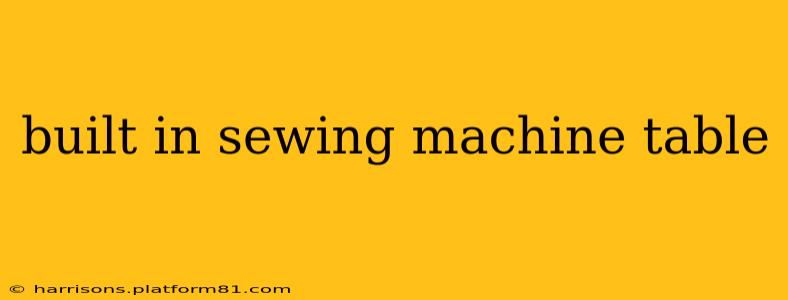A built-in sewing machine table offers a stylish and space-saving solution for crafters and sewing enthusiasts. This guide explores everything you need to know about these convenient furniture pieces, from design considerations to installation tips. Whether you're renovating your home or designing a new space, understanding the benefits and considerations of a built-in sewing machine cabinet can help you make an informed decision.
What are the benefits of a built-in sewing machine table?
Built-in sewing machine tables offer several key advantages over freestanding models:
-
Space Saving: They eliminate the need for a separate sewing machine table, maximizing floor space in smaller rooms or crafting areas. This is particularly beneficial in apartments or homes where space is at a premium.
-
Seamless Integration: A built-in table seamlessly integrates with your existing cabinetry, creating a cohesive and polished look. It can be customized to match your kitchen or craft room's design, ensuring a unified aesthetic.
-
Organized Storage: Many built-in sewing machine cabinets include drawers and cabinets for storing sewing supplies, patterns, and fabrics, keeping everything neatly organized and readily accessible.
-
Increased Stability: A built-in table provides a more stable work surface compared to a freestanding model, minimizing vibrations and ensuring smoother sewing.
What are the different types of built-in sewing machine tables?
There's a range of options available depending on your needs and preferences:
-
Cabinet-Style: These are fully enclosed cabinets with a hinged or pull-out top to reveal the sewing machine. They offer ample storage and a clean, streamlined appearance.
-
Drop-Leaf Style: These tables feature a drop-leaf design, allowing you to easily fold away the sewing surface when not in use. This maximizes space efficiency in smaller areas.
-
Custom-Built: For a truly personalized solution, you can commission a custom-built sewing machine cabinet tailored to your specific requirements and design preferences. This allows for complete control over features, size, and aesthetic.
-
Murphy Bed style: A unique variation that incorporates a fold-away sewing machine cabinet into the design of a Murphy bed, maximizing space in studio apartments or small homes.
How much does a built-in sewing machine table cost?
The cost of a built-in sewing machine table varies considerably depending on several factors:
-
Materials: The type of wood, countertop material, and hardware used significantly impact the price. Solid wood cabinets will generally be more expensive than those made from manufactured wood.
-
Size and Features: Larger cabinets with more storage space and elaborate features naturally cost more.
-
Customization: Custom-built cabinets are typically more expensive than ready-made options.
-
Installation: The cost of professional installation should also be considered in your budget.
Can I build a built-in sewing machine table myself?
Yes, you can build a built-in sewing machine table yourself if you have basic woodworking skills and access to the necessary tools. Many online resources offer detailed plans and tutorials. However, building a custom cabinet requires time, effort, and precision. If you're not comfortable with DIY projects, it's best to hire a professional carpenter or cabinet maker.
How do I install a built-in sewing machine table?
The installation process depends on the type of built-in sewing machine table you choose. Cabinet-style tables usually require mounting to existing cabinetry, while drop-leaf models may need to be attached to a wall or existing countertop. Always follow the manufacturer's instructions carefully. For complex installations or custom-built cabinets, it's strongly recommended to hire a professional installer to ensure proper fit and functionality.
What should I consider when choosing a built-in sewing machine table?
Several key factors should be considered when choosing a built-in sewing machine table:
-
Space Available: Carefully measure the space where you plan to install the table to ensure a proper fit.
-
Sewing Machine Size: Ensure the cabinet is large enough to accommodate your sewing machine and any accessories.
-
Storage Needs: Consider how much storage you need for sewing supplies and other items.
-
Style and Design: Choose a table that complements your existing cabinetry and overall décor.
-
Budget: Set a realistic budget before you start shopping.
By carefully considering these factors, you can select a built-in sewing machine table that perfectly meets your needs and enhances your sewing experience. Investing in a well-designed and well-installed built-in sewing machine table provides a functional and aesthetically pleasing addition to any home crafting space.
